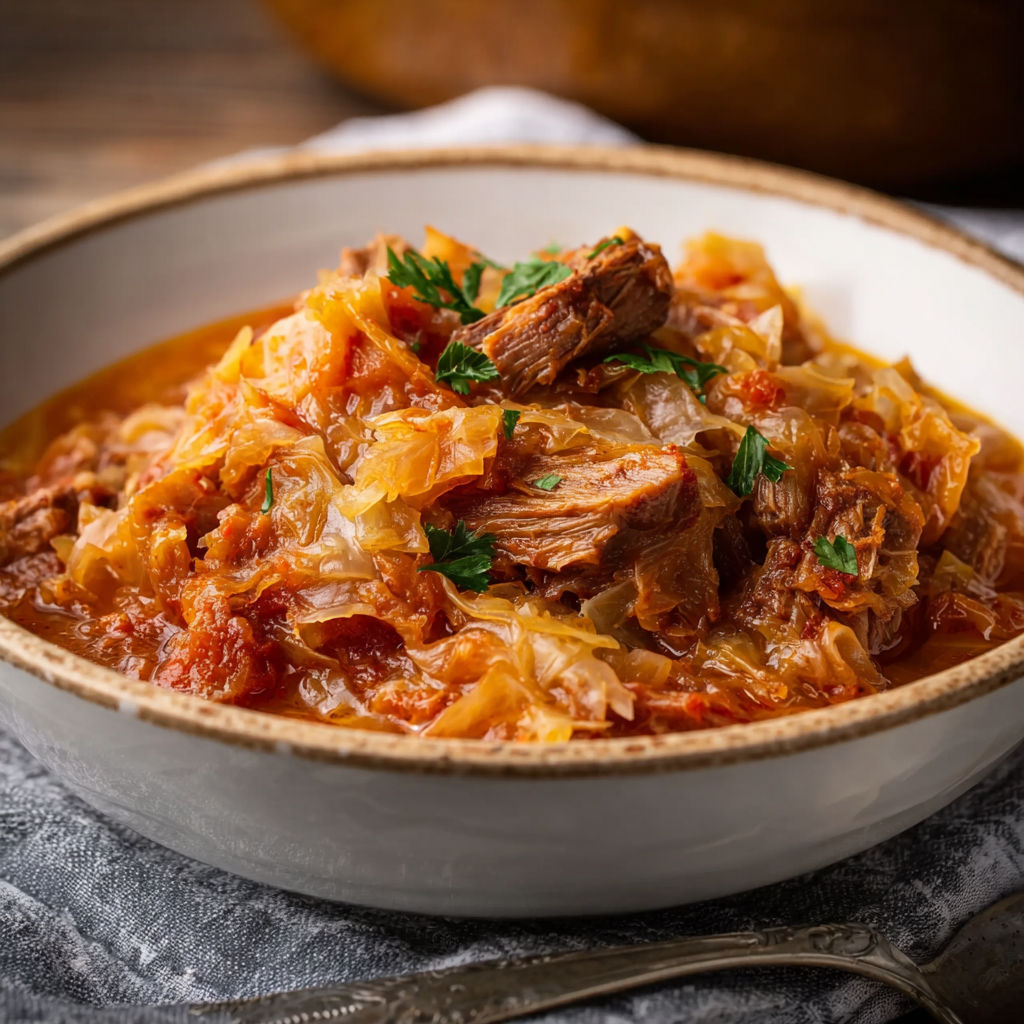 Pin
Pin
This warming Polish bigos brings together the soulful tastes of slow-cooked meats, sauerkraut, and comforting cabbage for a true hunter’s stew rooted in age-old tradition but made simple enough for a cozy weeknight meal at home.
Cooking bigos connects me with generations past. My grandmother always made hers with both pork and beef, and I love recreating that layered flavor at home. Nothing beats that first taste after a long simmer on the stovetop.
Gather Your Ingredients
- Sauerkraut: Essential for tangy depth, use one that is firm and not overly sour, rinse lightly if very strong
- White cabbage: Brings natural sweetness and balances the sauerkraut, freshness is key so choose one with crisp leaves and tight head
- Pork shoulder or belly: Rich and flavorful meat that breaks down beautifully during slow cooking, look for marbled pieces
- Polish kielbasa: Authentic smoky sausage contributes signature flavor, try to source from a reputable deli
- Beef stew meat or venison: Offers hearty texture and deep umami flavor, choose well-marbled pieces for best results
- Onion: A must for natural sweetness, finely chop for even distribution
- Garlic: Boosts overall savoriness, use fresh cloves for best taste
- Dried porcini mushrooms: Deliver earthy complexity, soak before chopping and reserve the liquid for added umami
- Prunes: A surprising touch of sweetness counterbalances the tartness of the kraut, opt for plump dried prunes
- Tomato paste: Gives subtle richness and complexity
- Juniper berries: Bright and woodsy, a classic Polish touch, bruise them lightly before using
- Caraway seeds: Key for their aromatic pungency
- Bay leaves: Gently perfume the stew as it cooks
- Allspice berries: Impart warmth and round out flavors, use whole for a gentle infusion
- Red wine: Adds depth and a hint of acidity, optional but highly recommended, choose a dry one
- Mushroom soaking liquid: Full of savory notes, do not skip as it boosts mushroom essence
- Water or broth to cover: Ensures the stew simmers gently, use low sodium broth for best control over salt
- Salt and pepper: For perfect seasoning, taste as you go
How to Make It
- Prepare the Porcini Mushrooms:
- Place dried porcini mushrooms in a heatproof bowl and pour boiling water over them just enough to submerge. Cover with a plate and let them soak for at least thirty minutes. Once softened, lift them out with a slotted spoon and give them a rough chop. Reserve the soaking liquid.
- Brown All the Meats:
- Heat oil in a large heavy pot over medium high. Working in batches, sear the diced pork until browned on all sides, about five to seven minutes per batch. Remove browned pork to a plate, then repeat with beef, browning well on all sides. Do not rush as this part builds the stew’s deep foundation. Add the sliced kielbasa to the same pot and cook until lightly browned and aromatic, about three to four minutes. Remove with the other meats.
- Sauté Aromatics and Spices:
- Without cleaning the pot, reduce heat to medium and add a splash of oil if needed. Toss in chopped onion, cooking for six to eight minutes until golden and soft. Add minced garlic, caraway seeds, juniper berries, and tomato paste. Stir frequently for about one minute until the mixture is fragrant and the tomato paste darkens.
- Wilt the Cabbage:
- Add shredded white cabbage to the pot. Stir often and cook for ten minutes until the cabbage wilts and softens, pulling up any brown bits from the bottom for extra flavor.
- Combine Main Ingredients:
- Stir in the sauerkraut, lightly rinsed and drained if overly sour. Add the soaked and chopped mushrooms, chopped prunes, bay leaves, and allspice berries. Mix well to distribute everything evenly.
- Return Meats and Liquid:
- Pour in the reserved mushroom soaking liquid. Then return all browned meats and kielbasa to the pot. Add the optional red wine and enough water or broth to just cover all ingredients. Season the pot with salt and pepper.
- Long Simmer for Flavor Development:
- Bring the stew to a gentle simmer then lower the heat. Cover with a lid slightly ajar and let it simmer for at least two to three hours, stirring occasionally to prevent sticking. If it starts to dry out, add a splash of broth as needed. Taste and adjust seasoning before serving.

My favorite addition is dried prunes — they add a mysterious sweetness everyone tries to guess. I will never forget sharing steaming bowls of bigos at a family reunion with my uncle passing down his secret to always use a splash of red wine.
Flavor Boosters
Brown your meats thoroughly for the richest base. A little wine can transform the stew’s depth of flavor. Leftovers freeze wonderfully — just defrost slowly before reheating.
Serving Suggestions
Spoon bigos over mashed potatoes or fresh rye bread for a satisfying meal. Try topping with a dollop of sour cream and chopped dill for a modern flair. Little potato dumplings or kluski are traditional and excellent alongside.
Creative Twists
No kielbasa? Substitute with any good quality smoked sausage or even chorizo. Venison brings wild game flavor but beef stew meat is a reliable swap. For a vegetarian twist, use mushrooms, tofu, smoked paprika, and a splash of liquid smoke in place of meats.

Enjoy the taste of tradition in every spoonful — bigos brings old world comfort to your table, and only gets better every time you make it.
Common Questions About This Recipe
- → What types of meat work best for bigos?
Bigos traditionally uses a mix of pork, beef, or venison, along with Polish kielbasa for smoky depth.
- → Why are prunes used in this dish?
Chopped prunes add subtle sweetness, balance the sauerkraut’s tang, and deepen the overall flavor.
- → Can I make bigos ahead of time?
Yes, bigos develops even richer flavor when made in advance and reheated over one or two days.
- → Is red wine necessary in the stew?
Wine is optional but imparts extra complexity; you can omit it or substitute with broth if preferred.
- → How do I avoid the stew drying out?
Simmer covered with the lid slightly ajar, adding water or broth as needed to maintain moisture.
